The Fish Tanks of the Mediterranean Sea
Abstract
1. Introduction
Methodology
2. Overview of Fish Tanks Characteristics
2.1. Architecture of Roman Fish Tanks, Technical Aspects and Sea Hydraulics
2.2. Architectural Elements Used as Sea Level Indicators
2.2.1. Protective Docks
2.2.2. Foot-Walks (Crepidine)
2.2.3. Sluice Gates (Cataractae)
2.2.4. Channels
3. Distribution of Fish Tanks in the Mediterranean
3.1. Fish Tanks of Spain
3.2. Fish Tanks of France
3.3. Fish Tanks along the Tyrrhenian Coast of Italy
3.4. Adriatic Sea Fish Tanks
3.5. Fish Tanks of Greece
3.6. Fish Tanks of Israel
3.7. Fish Tanks of Egypt
3.8. Fish Tanks of Lebanon
4. Fish Tanks as Sea Level Indicators
5. Overview of Construction and Architectural Characteristics
Supplementary Materials
Author Contributions
Funding
Institutional Review Board Statement
Informed Consent Statement
Data Availability Statement
Acknowledgments
Conflicts of Interest
References
- Higginbotham, J. Piscinae: Artificial Fishponds in Roman Italy; University of North Carolina Press: Chapel Hill, NC, USA, 1997. [Google Scholar]
- Giacopini, L.; Marchesini, B.; Rustico, L. L’Itticultura Nell’antichita; Enel: Rome, Italy, 1994. [Google Scholar]
- Lambeck, K.; Antonioli, F.; Purcell, A.; Silenzi, S. Sea-level change along the Italian coast for the past 10,000 yr. Quat. Sci. Rev. 2004, 23, 1567–1598. [Google Scholar] [CrossRef]
- Torab, M. Geomophological & geoarchaeological indicators of the Holocene sea-level changes on Ras El Hekma area, NW coast of Egypt. J. Afr. Earth Sci. 2016, 114, 85–95. [Google Scholar] [CrossRef]
- Evelpidou, N.; Repapis, C.; Zerefos, C.; Tzalas, H.; Synolakis, C. Geophysical Phenomena and the Alexandrian Littoral; Archaeopress: Oxford, UK, 2019; ISBN 9781789692358. [Google Scholar]
- Mourtzas, N.D. Archaeological indicators for sea level change and coastal neotectonic deformation: The submerged Roman fish tanks of the gulf of Matala, Crete, Greece. J. Archaeol. Sci. 2012, 39, 884–895. [Google Scholar] [CrossRef]
- Mourtzas, N.D. Fish tanks of eastern Crete (Greece) as indicators of the Roman sea level. J. Archaeol. Sci. 2012, 39, 2392–2408. [Google Scholar] [CrossRef]
- Davaras, C. A rock-cut fish tank near Hierapetra. Archaeol. Delt. 1975, 30A, 149–154. [Google Scholar]
- Davaras, C. Rock-cut fish tanks in Eastern Crete. Annu. Br. Sch. Athens 1974, 69, 87–93. [Google Scholar] [CrossRef]
- Florido, E.; Auriemma, R.; Faivre, S.; Radić Rossi, I.; Antonioli, F.; Furlani, S.; Spada, G. Istrian and Dalmatian fishtanks as sea-level markers. Quat. Int. 2011, 232, 105–113. [Google Scholar] [CrossRef]
- Auriemma, R.; Solinas, E. Archaeological remains as sea level change markers: A review. Quat. Int. 2009, 206, 134–146. [Google Scholar] [CrossRef]
- Carre, M.-B.; Katunarić, T. Le Vivier de Katoro (Istrie, Croatie). Chron. Act. Archéologiques L’école Française Rome 2012. [Google Scholar] [CrossRef]
- Caballero-Rubio, F.J.; Viñals, M.J.; Tormo-Esteve, S. The Roman fish tanks of the Western Mediterranean basin as potential scenarios for research on sea-level changes. J. Cult. Herit. Manag. Sustain. Dev. 2022, 12, 92–106. [Google Scholar] [CrossRef]
- Bernal-Casasola, D. Piscicultura y ostricultura en Baetica. Nuevos tiempos, nuevas costumbres. In Pescar con Arte. Fenicios y Romanos en el Origen de los Aparejos Andaluces; Bernal-Casasola, D., Ed.; Universidad de Cádiz: Cádiz, Spain, 2011; pp. 137–160. [Google Scholar]
- Morhange, C.; Marriner, N.; Excoffon, P.; Bonnet, S.; Flaux, C.; Zibrowius, H.; Goiran, J.-P.; Amouri, M. El Relative Sea-Level Changes During Roman Times in the Northwest Mediterranean: The 1st Century A.D. Fish Tank of Forum Julii, Fréjus, France. Geoarchaeology 2013, 28, 363–372. [Google Scholar] [CrossRef]
- Galili, E.; Salamon, A.; Gambash, G.; Zviely, D. Archaeological and natural indicators of sea-level and coastal changes: The case study of the caesarea roman harbor. Geosciences 2021, 11, 306. [Google Scholar] [CrossRef]
- Anzidei, M.; Antonioli, F.; Benini, A.; Lambeck, K.; Sivan, D.; Serpelloni, E.; Stocchi, P. Sea level change and vertical land movements since the last two millennia along the coasts of southwestern Turkey and Israel. Quat. Int. 2011, 232, 13–20. [Google Scholar] [CrossRef]
- Yasur-Landau, A.; Shtienberg, G.; Gambash, G.; Spada, G.; Melini, D.; Arkin-Shalev, E.; Tamberino, A.; Reese, J.; Levy, T.E.; Sivan, D. New relative sea-level (RSL) indications from the Eastern Mediterranean: Middle Bronze Age to the Roman period (~3800–1800 y BP) archaeological constructions at Dor, the Carmel coast, Israel. PLoS ONE 2021, 16, e0251870. [Google Scholar] [CrossRef]
- Dean, S.; Horton, B.P.; Evelpidou, N.; Cahill, N.; Spada, G.; Sivan, D. Can we detect centennial sea-level variations over the last three thousand years in Israeli archaeological records? Quat. Sci. Rev. 2019, 210, 125–135. [Google Scholar] [CrossRef]
- Evelpidou, N.; Pirazzoli, P.; Vassilopoulos, A.; Spada, G.; Ruggieri, G.; Tomasin, A. Late Holocene Sea Level Reconstructions Based on Observations of Roman Fish Tanks, Tyrrhenian Coast of Italy. Geoarchaeology 2012, 27, 259–277. [Google Scholar] [CrossRef]
- Schmiedt, G. Il Livello Antico del Mar Tirreno; E. Olschki: Florence, Italy, 1972. [Google Scholar]
- Aucelli, P.P.C.; Mattei, G.; Caporizzo, C.; Cinque, A.; Troisi, S.; Peluso, F.; Stefanile, M.; Pappone, G. Ancient Coastal Changes Due to Ground Movements and Human Interventions in the Roman Portus Julius (Pozzuoli Gulf, Italy): Results from Photogrammetric and Direct Surveys. Water 2020, 12, 658. [Google Scholar] [CrossRef]
- Lambeck, K.; Anzidei, M.; Antonioli, F.; Benini, A.; Esposito, A. Sea level in Roman time in the Central Mediterranean and implications for recent change. Earth Planet. Sci. Lett. 2004, 224, 563–575. [Google Scholar] [CrossRef]
- Vacchi, M.; Marriner, N.; Morhange, C.; Spada, G.; Fontana, A.; Rovere, A. Multiproxy assessment of Holocene relative sea-level changes in the western Mediterranean: Sea-level variability and improvements in the definition of the isostatic signal. Earth-Sci. Rev. 2016, 155, 172–197. [Google Scholar] [CrossRef]
- Benjamin, J.; Rovere, A.; Fontana, A.; Furlani, S.; Vacchi, M.; Inglis, R.H.; Galili, E.; Antonioli, F.; Sivan, D.; Miko, S.; et al. Late Quaternary sea-level changes and early human societies in the central and eastern Mediterranean Basin: An interdisciplinary review. Quat. Int. 2017, 449, 29–57. [Google Scholar] [CrossRef]
- Columella. De Re Rustica, XVII. In Il Livello Antico del Mar Tirreno. Testimonianze da Resti Archeologici; Schmiedt, G., Ed.; E. Olschki: Florence, Italy, 1972. [Google Scholar]
- Varro. De Re Rustica, III. In Il Livello Antico del Mar Tirreno. Testimonianze da Resti Archeologici; Schmiedt, G., Ed.; E. Olschki: Florence, Italy, 1972. [Google Scholar]
- Chiappella, V.G. Esplorazione della cosiddetta “Piscina di Lucullo” sul lago di Paola. Atti Della Accademia Nazionale Dei Lincei (CCCLXII). Not. Scavi Antich. 1965, 8, 146–160. [Google Scholar]
- McCann, A.M. The Roman Port and Fishery of Cosa: A Center of Ancient Trade; Princeton University Press: Princeton, NJ, USA, 1987. [Google Scholar]
- Gazda, E.K.; McCann, A.M. Chapter VII. Reconstruction and Function: Port, Fishery, and Villa. In The Roman Port and Fishery of Cosa; Princeton University Press: Princeton, NJ, USA, 2017; pp. 137–159. [Google Scholar]
- Del Rosso, R. Pesche e Peschiere Antiche e Moderne nell’Etruria Marittima; Osvaldo Paggi: Firenze, Italy, 1905. [Google Scholar]
- Ricotti, E.S.P. The importance of water in Roman Garden Triclinia. In Ancient Roman Villa Gardens; MacDougall, E.B., Ed.; Dumbarton Oaks: Washington, DC, USA, 1987; pp. 135–183. [Google Scholar]
- Lambeck, K.; Anzidei, M.; Antonioli, F.; Benini, A.; Verrubbi, V. Tyrrhenian sea level at 2000 BP: Evidence from Roman age fish tanks and their geological calibration. Rend. Lincei. Sci. Fis. Nat. 2018, 29, 69–80. [Google Scholar] [CrossRef]
- Martial. Epigrammaton libri X. Available online: https://www.tertullian.org/fathers/martial_epigrams_book10.htm (accessed on 1 January 2022).
- Pirazzoli, P.A. Sea-level changes and crustal movements in the Hellenic arc (Greece), the contribution of archaeological and historical data. In Archaeology of Coastal Changes, Proceedings of the First International Symposium “Cities on the Sea—Past and Present”, Haifa, Israel, 22–29 September 1986; Raban, A., Ed.; BAR International Series: Haifa, Israel, 1988; pp. 157–184. [Google Scholar]
- Caputo, M.; Pieri, L. Eustatic sea variation in the last 2000 years in the Mediterranean. J. Geophys. Res. 1976, 81, 5787–5790. [Google Scholar] [CrossRef]
- Flemming, N.C.; Webb, C.O. Tectonic and eustatic coastal changes during the last 10,000 years derived from archaeological data. Z. Geomorphol. Suppl. 1986, 62, 1–29. [Google Scholar]
- Leoni, G.; Dai Pra, G. Variazioni del Livello del Mare nel Tardo Olocene (Ultimi 2500 Anni) lungo la Costa del Lazio in Base ad Indicatori Geoarcheologici; ENEA: Rome, Italy, 1997. [Google Scholar]
- Laborel, J.; Morhange, C.; Lafont, R.; Le Campion, J.; Laborel-Deguen, F.; Sartoretto, S. Biological evidence of sea-level rise during the last 4500 years on the rocky coasts of continental southwestern France and Corsica. Mar. Geol. 1994, 120, 203–223. [Google Scholar] [CrossRef]
- Devillers, B.; Excoffon, P.; Morhange, C.; Bonnet, S.; Bertoncello, F. Relative sea-level changes and coastal evolution at Forum Julii (Fréjus, Provence). Comptes Rendus Geosci. 2007, 339, 329–336. [Google Scholar] [CrossRef]
- Aucelli, P.; Cinque, A.; Mattei, G.; Pappone, G. Historical sea level changes and effects on the coasts of Sorrento Peninsula (Gulf of Naples): New constrains from recent geoarchaeological investigations. Palaeogeogr. Palaeoclimatol. Palaeoecol. 2016, 463, 112–125. [Google Scholar] [CrossRef]
- Leatham, J.; Hood, S. Sub-marine exploration in Crete, 1955. Annu. Br. Sch. Athens 1959, 53, 263–280. [Google Scholar] [CrossRef]
- Stanley, D.J. Evaluating use of rock-hewn features for sea level measurement, Israeli Coast. J. Coast. Res. 1999, 15, 326–331. [Google Scholar]
- Dean, S. 3,000 Years of East Mediterranean Sea Levels: Archaeological Indicators from Greece Combined with Israeli Coast Data; University of Haifa Faculty: Haifa, Israel, 2015. [Google Scholar]
- Galili, E.; Sharvit, J. Ancient coastal installations and the tectonic stability of the Israeli coast in historical times. Geol. Soc. London Spec. Publ. 1999, 146, 147–163. [Google Scholar] [CrossRef]
- Bartocci, M. Penisola di Abukir. Piano generale con indicazioni (in rosso) delle rovine di Canopo e di Menuti. In Monuments de l’Égypte Gréco-Romaine, Vol I; Breccia, E., Ed.; Officine de l’Istituto Italiano d’Arte Grafiche: Bergamo, Italy, 1926. [Google Scholar]
- Breccia, E. Alexandrea Ad Aegyptum; Instituto Italiano d’Arti Grafiche: Bergamo, Italy, 1926. [Google Scholar]
- Peltier, W.R.; Argus, D.F.; Drummond, R. Space geodesy constrains ice age terminal deglaciation: The global ICE-6G_C (VM5a) model. J. Geophys. Res. Solid Earth 2015, 120, 450–487. [Google Scholar] [CrossRef]
- Lambeck, K.; Purcell, A.; Johnston, P.; Nakada, M.; Yokoyama, Y. Water-load definition in the glacio-hydro-isostatic sea-level equation. Quat. Sci. Rev. 2003, 22, 309–318. [Google Scholar] [CrossRef]
- Spada, G.; Stocchi, P. SELEN: A Fortran 90 program for solving the “sea-level equation. ” Comput. Geosci. 2007, 33, 538–562. [Google Scholar] [CrossRef]
- Goiran, J.-P.; Chapkanski, S.; Régagnon, E.; Pavlopoulos, K.; Fouache, E. Preliminary Results of Rock-cut Fish Tanks Evidence Along the Tyre Coast of Lebanon. Implication for Ancient Sea-level Reconstruction. BAAL 2019, 19, 259–266. [Google Scholar]
- Antonioli, F.; Anzidei, M.; Lambeck, K.; Auriemma, R.; Gaddi, D.; Furlani, S.; Orrù, P.; Solinas, E.; Gaspari, A.; Karinja, S.; et al. Sea-level change during the Holocene in Sardinia and in the northeastern Adriatic (central Mediterranean Sea) from archaeological and geomorphological data. Quat. Sci. Rev. 2007, 26, 2463–2486. [Google Scholar] [CrossRef]
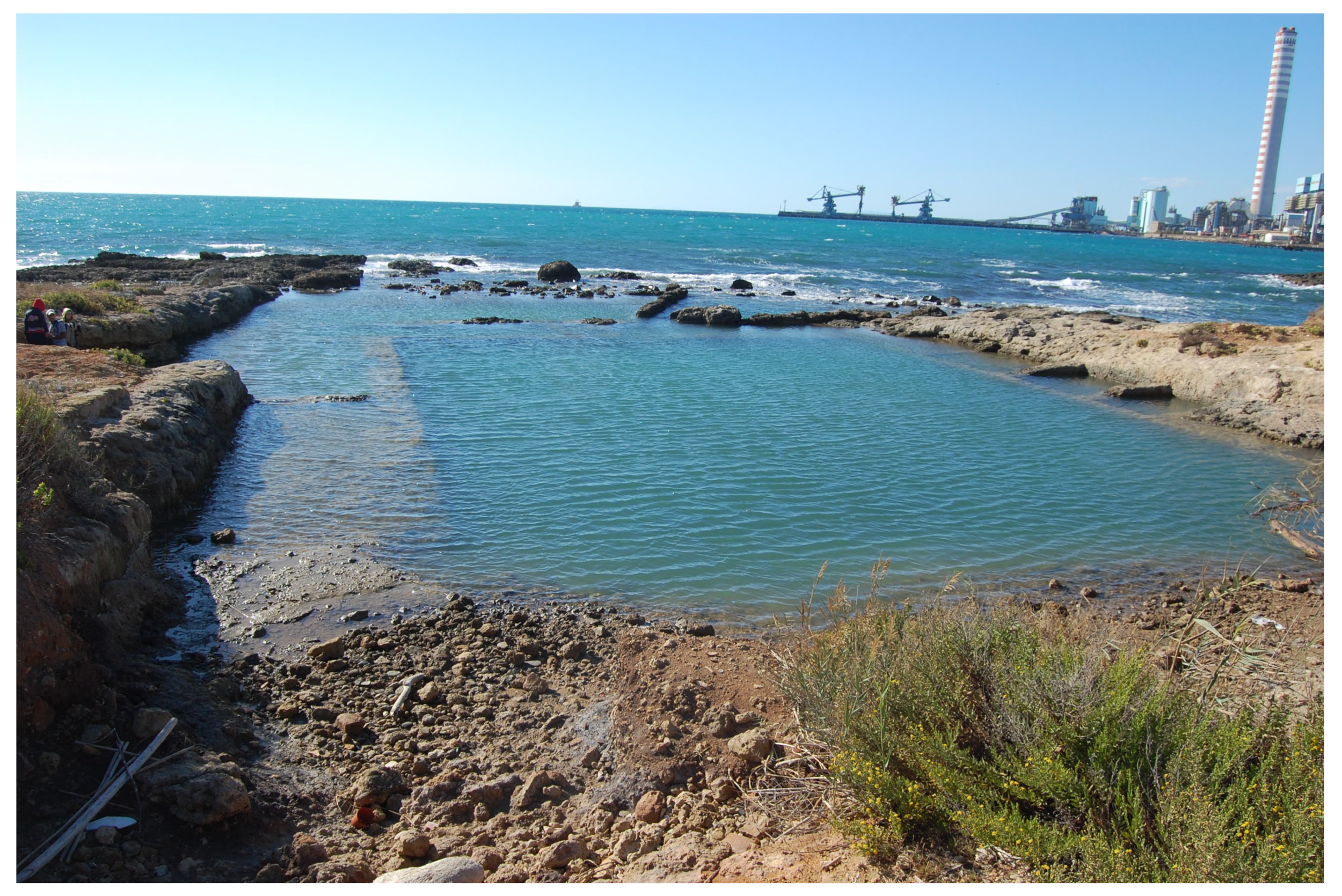
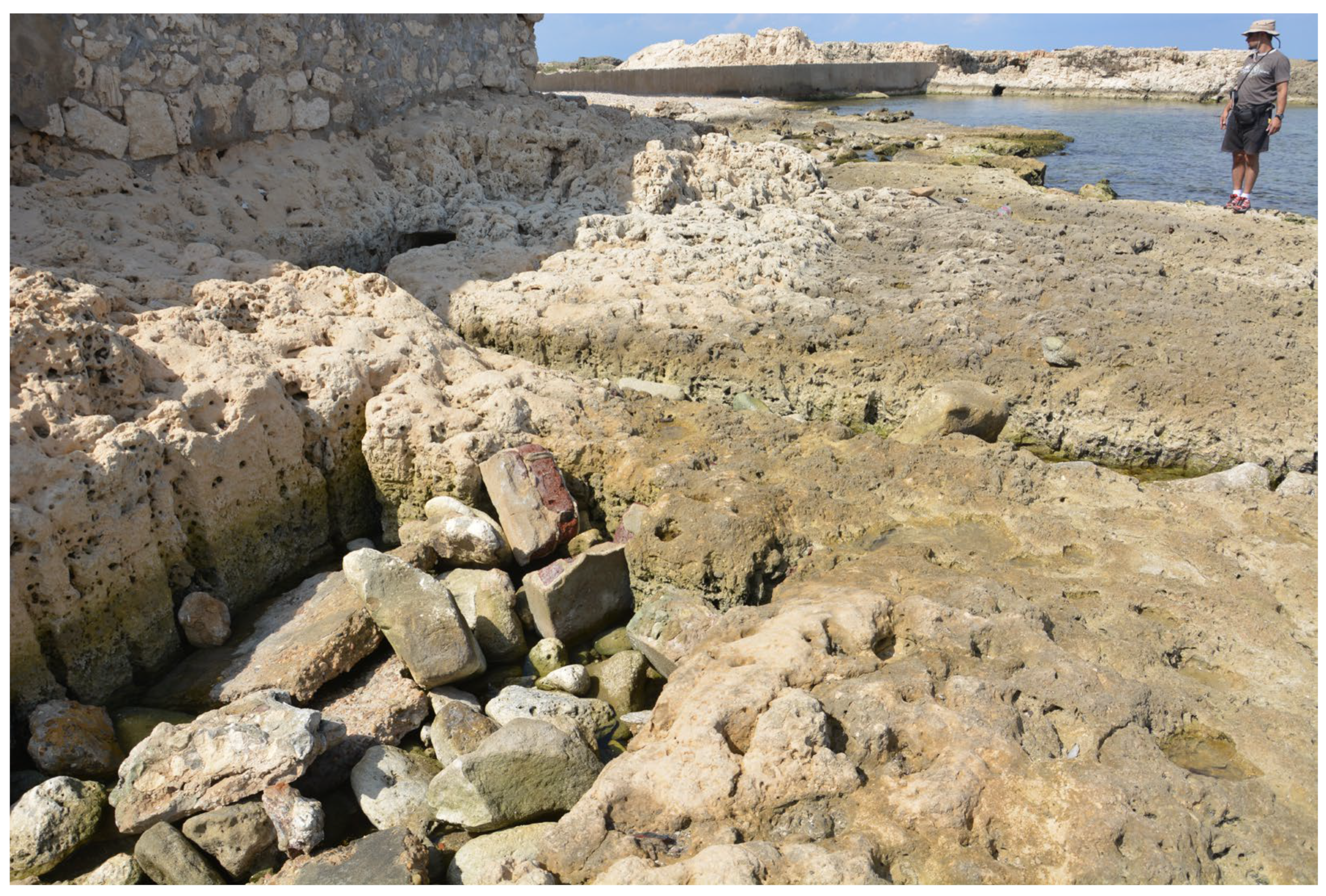
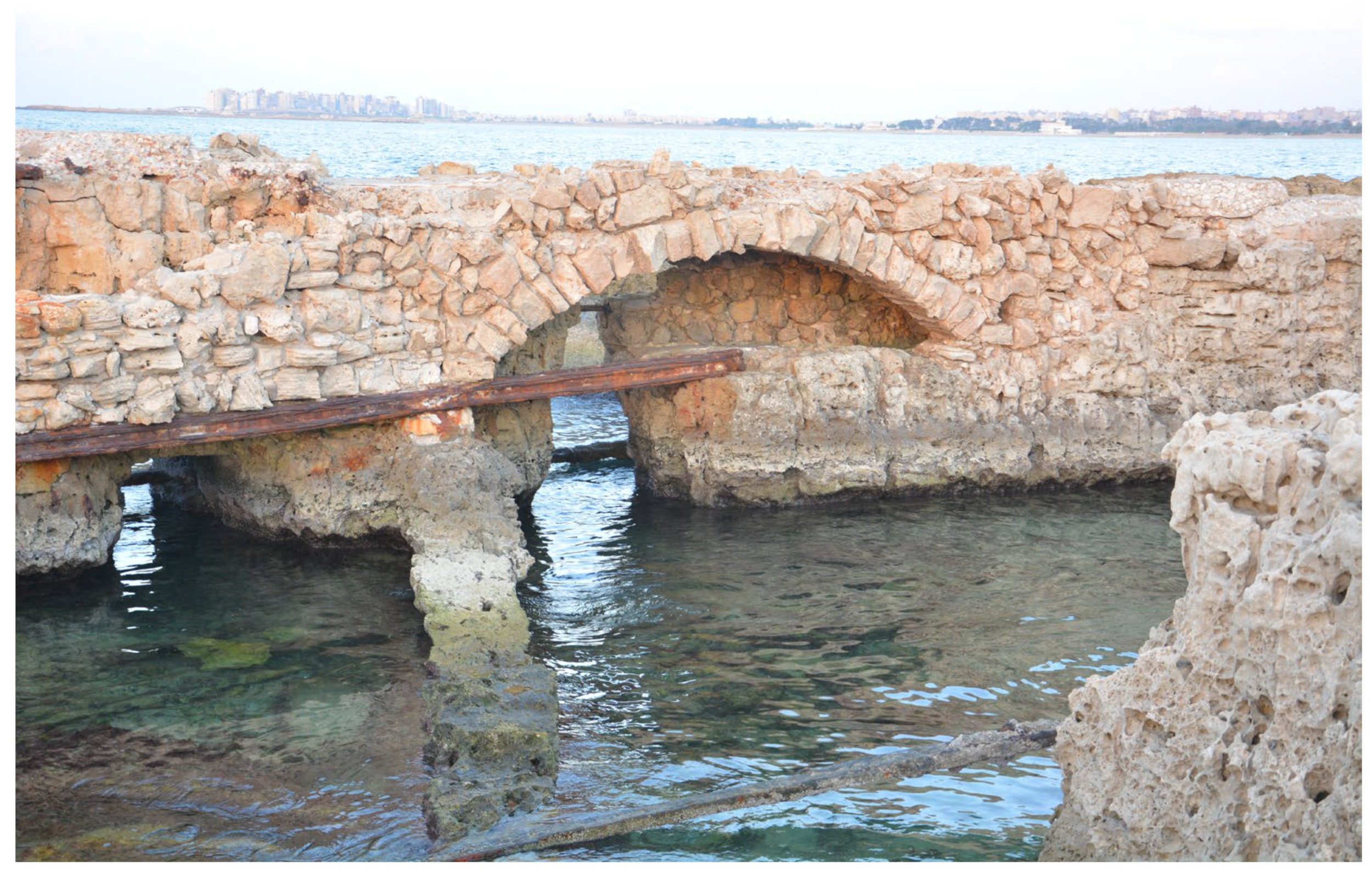
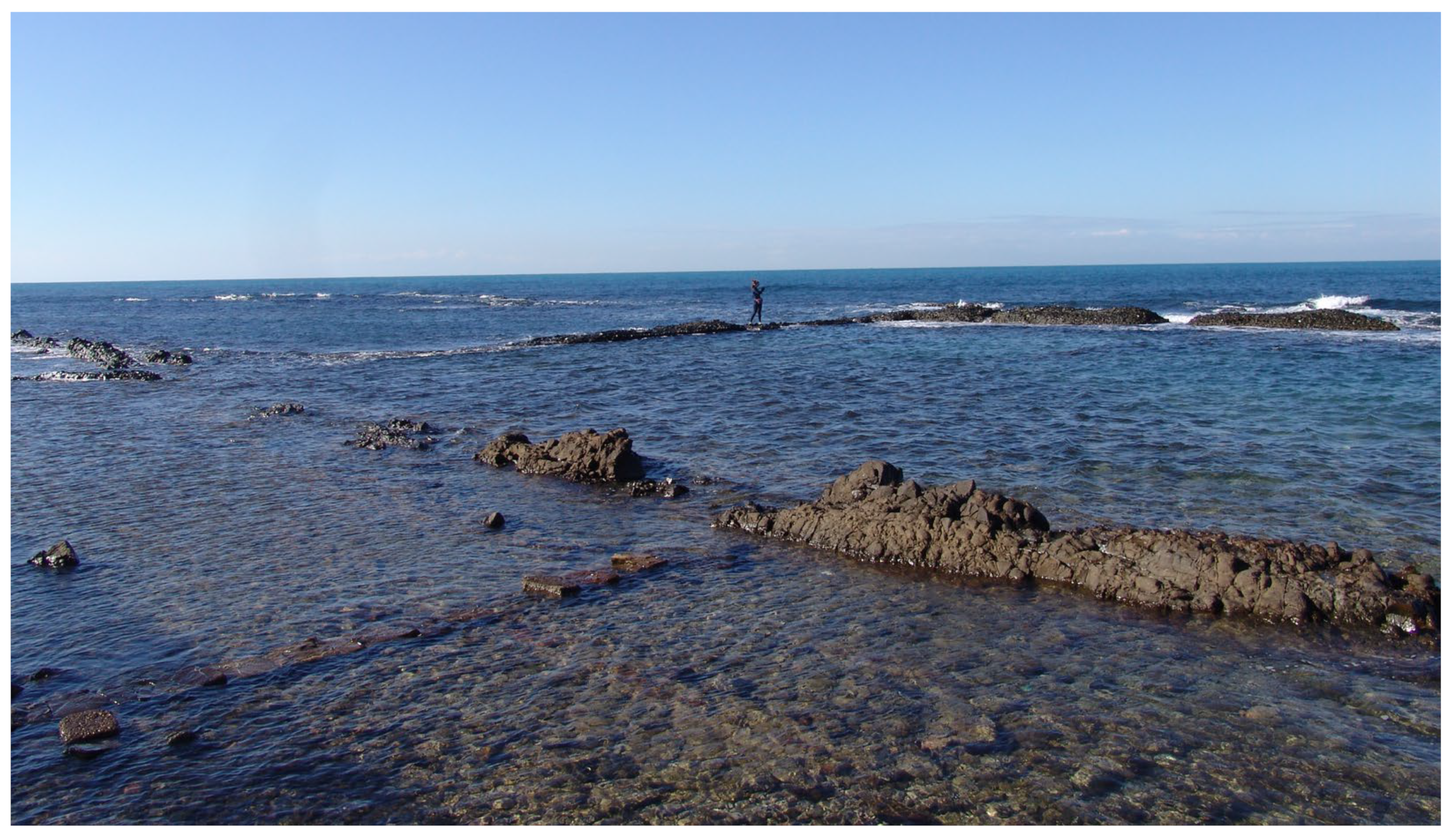


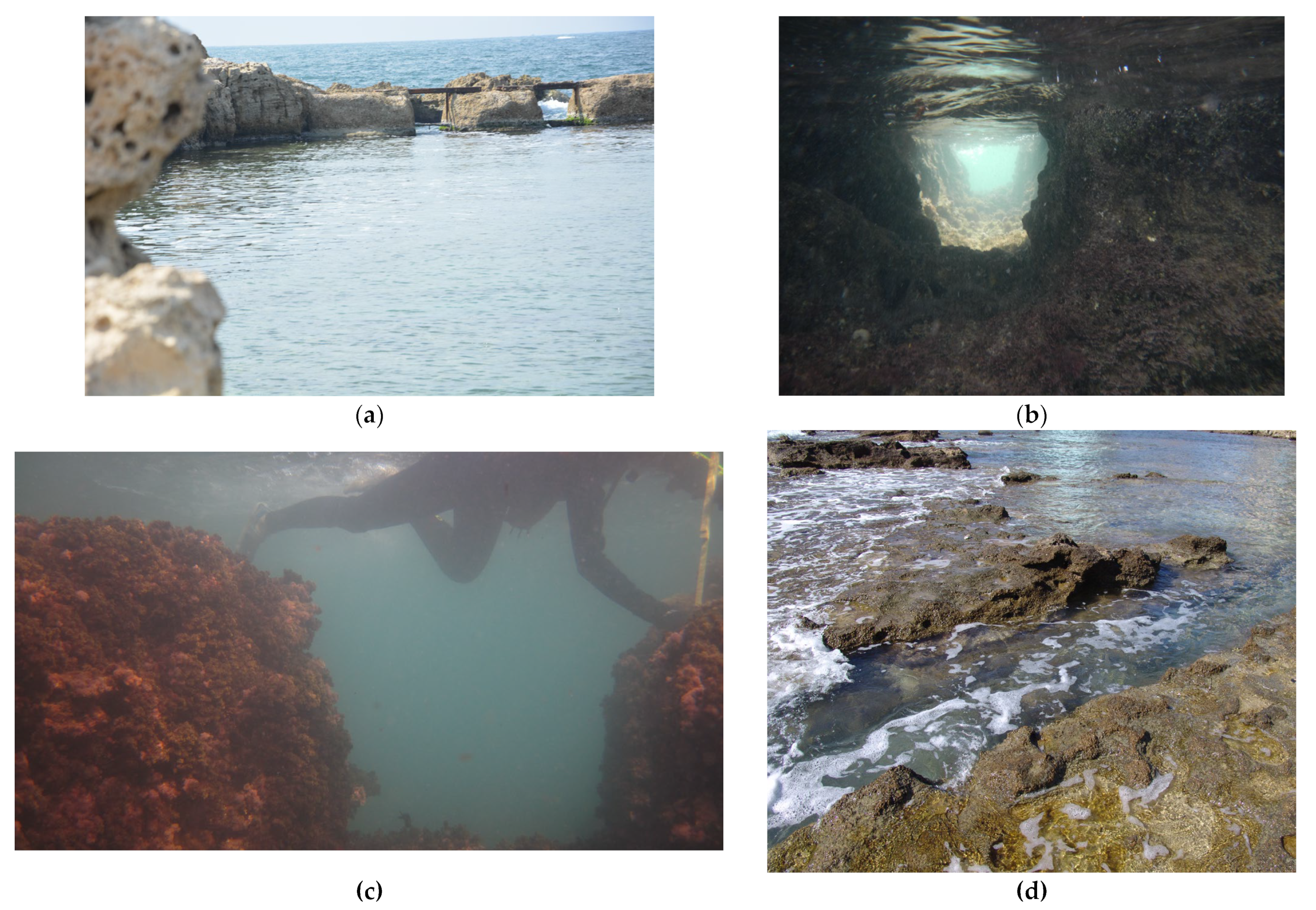



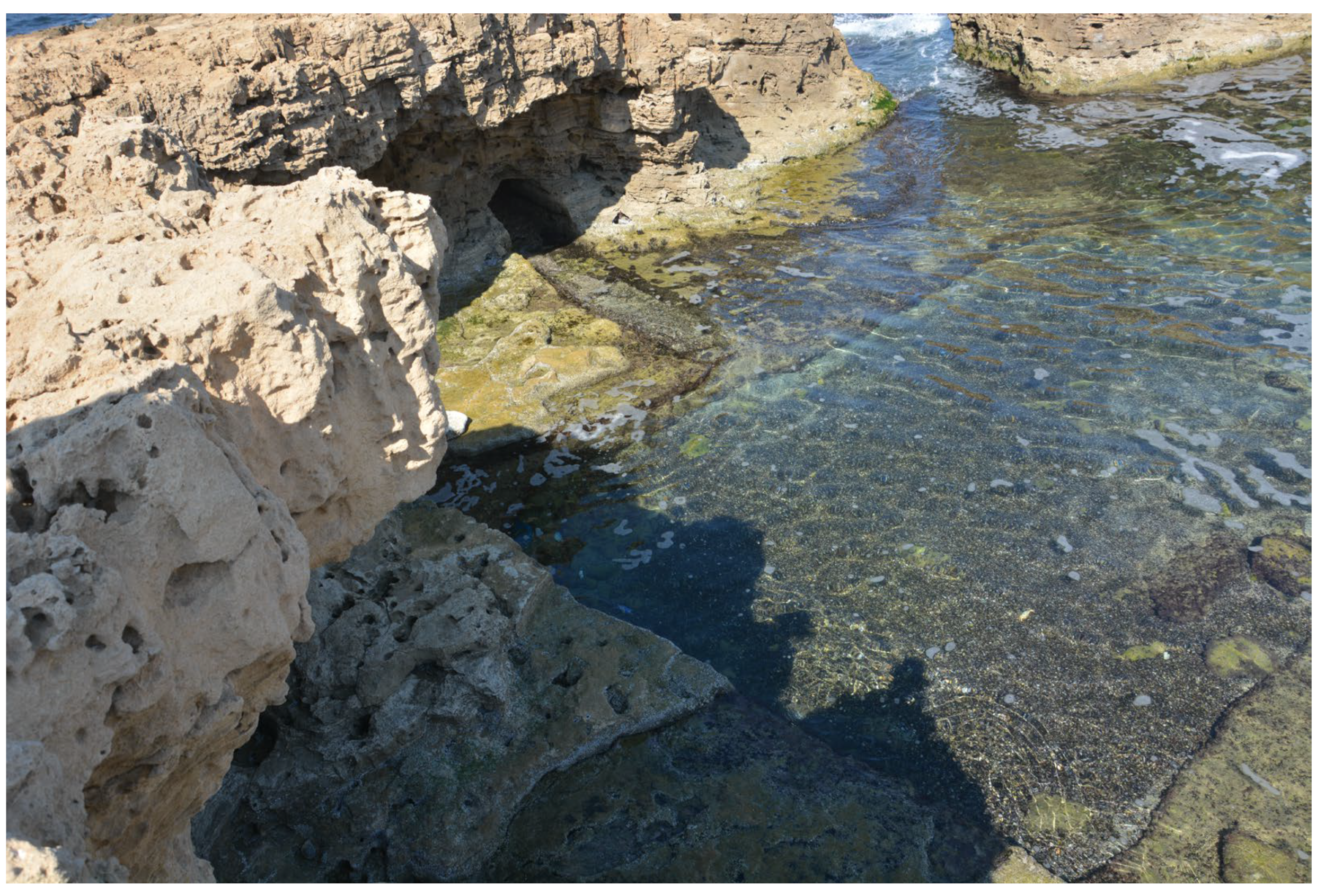
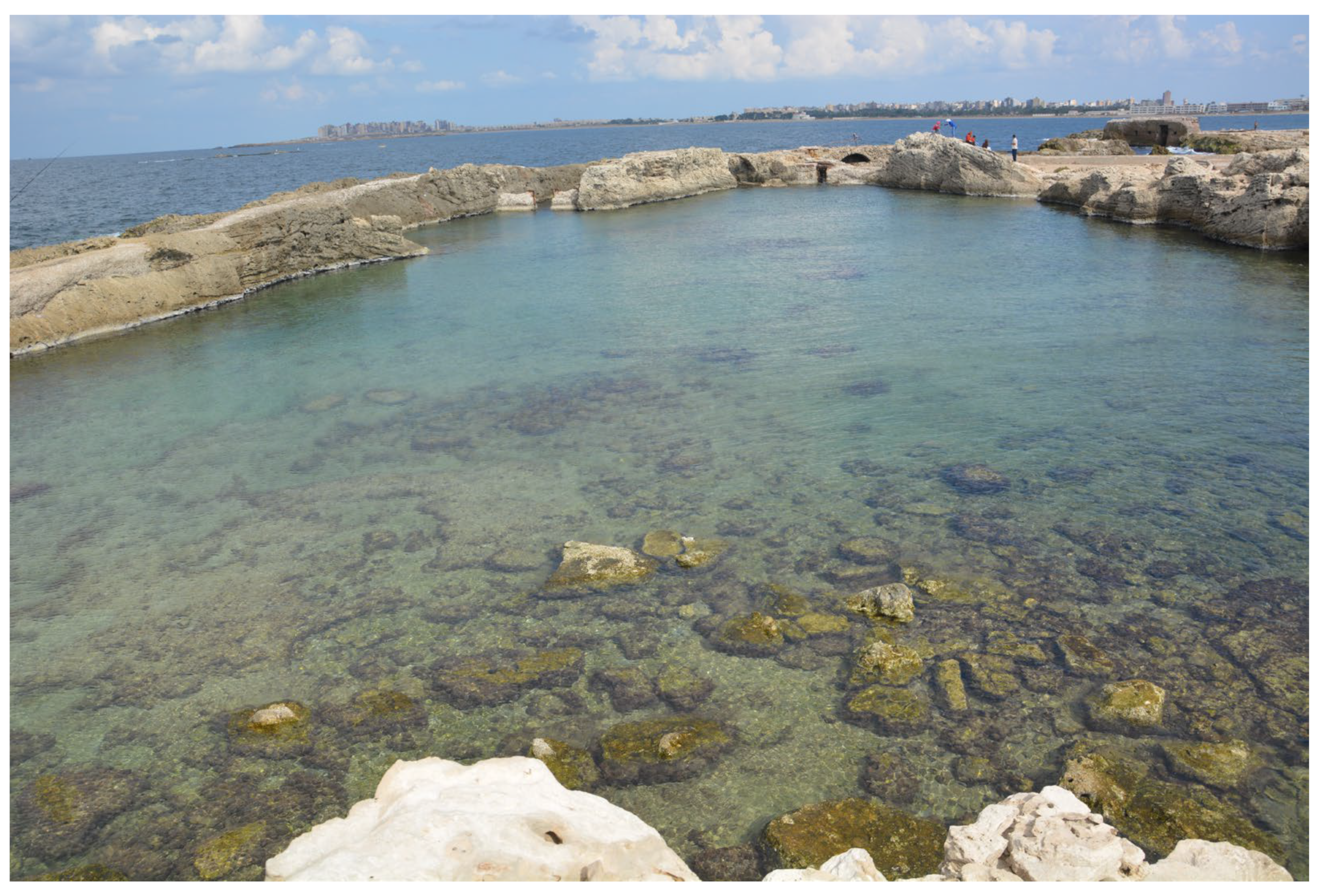
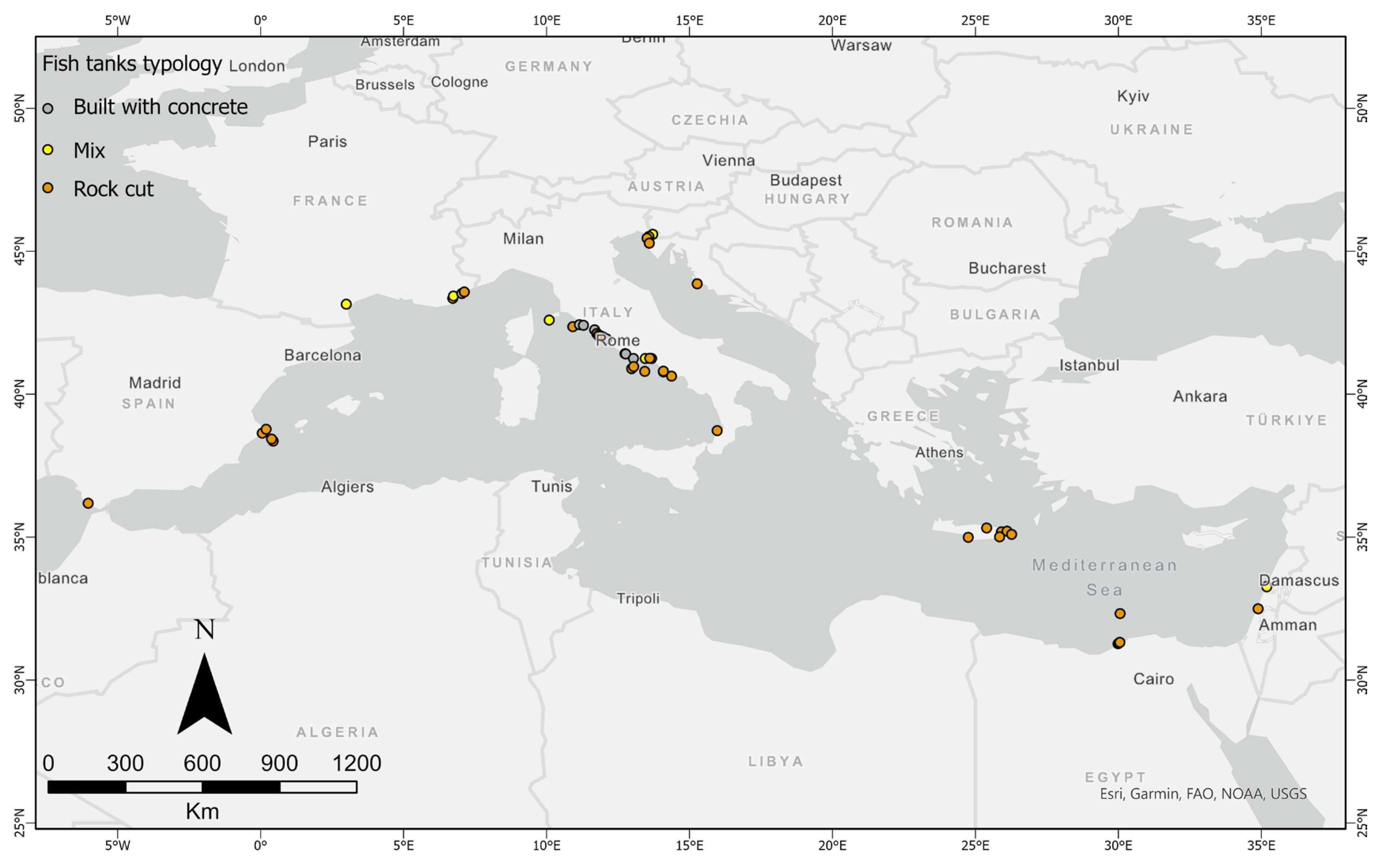
| Fish Tank Region | Sea Level (m) | Reference |
|---|---|---|
| Frejus (France) | −0.4 ± 0.10 | [15] |
| Tyrrhenian coast of Italy | −0.58 ± 0.05 to −0.32 ± 0.05 | [20] |
| −1.35 ± 0.07 | [23] | |
| Sorrento (Italy) | −1.1 ± 0.30 | [22] |
| S. Bartolomeo (Slovenia) | −1.4 ± 0.2 | [10,52] |
| Fisine (Slovenia) | −1.5 ± 0.2 | [10] |
| Catoro (Croatia) | −1.75 ± 0.2 m | [10] |
| Kupanja (Croatia) | −1.4 ± 0.2 m | [10] |
| Svrsata (Croatia) | −1.5 ± 0.2 | [10] |
| Matala (Crete) | −1.24 ± 0.09 | [7] |
| Chersonissos (Crete) | −1.24 ± 0.09 | [7] |
| Mochlos (Crete) | −1.24 ± 0.09 | [7] |
| Gulf of Zakros (Crete) | −1.24 ± 0.09 | [7] |
| Ferma (Crete) | −1.24 ± 0.09 | [7] |
| Alexandria (Egypt) | −0.70 ± 0.05 | [5] |
| North and south Tyre (Lebanon) | −0.60 | [51] |
Disclaimer/Publisher’s Note: The statements, opinions and data contained in all publications are solely those of the individual author(s) and contributor(s) and not of MDPI and/or the editor(s). MDPI and/or the editor(s) disclaim responsibility for any injury to people or property resulting from any ideas, methods, instructions or products referred to in the content. |
© 2023 by the authors. Licensee MDPI, Basel, Switzerland. This article is an open access article distributed under the terms and conditions of the Creative Commons Attribution (CC BY) license (https://creativecommons.org/licenses/by/4.0/).
Share and Cite
Oikonomou, P.; Karkani, A.; Evelpidou, N.; Kampolis, I.; Spada, G. The Fish Tanks of the Mediterranean Sea. Quaternary 2023, 6, 24. https://doi.org/10.3390/quat6020024
Oikonomou P, Karkani A, Evelpidou N, Kampolis I, Spada G. The Fish Tanks of the Mediterranean Sea. Quaternary. 2023; 6(2):24. https://doi.org/10.3390/quat6020024
Chicago/Turabian StyleOikonomou, Paris, Anna Karkani, Niki Evelpidou, Isidoros Kampolis, and Giorgio Spada. 2023. "The Fish Tanks of the Mediterranean Sea" Quaternary 6, no. 2: 24. https://doi.org/10.3390/quat6020024
APA StyleOikonomou, P., Karkani, A., Evelpidou, N., Kampolis, I., & Spada, G. (2023). The Fish Tanks of the Mediterranean Sea. Quaternary, 6(2), 24. https://doi.org/10.3390/quat6020024










